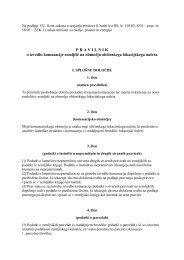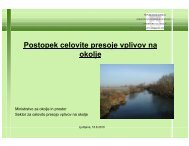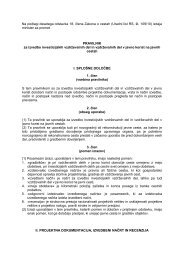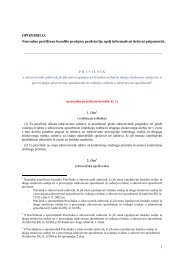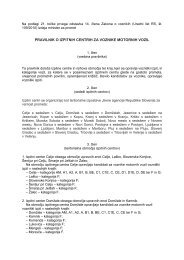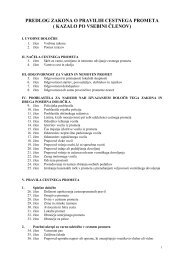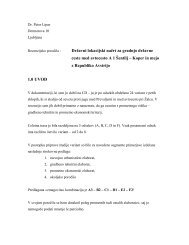evropska konvencija o krajini - Ministrstvo za infrastrukturo in prostor
evropska konvencija o krajini - Ministrstvo za infrastrukturo in prostor
evropska konvencija o krajini - Ministrstvo za infrastrukturo in prostor
Create successful ePaper yourself
Turn your PDF publications into a flip-book with our unique Google optimized e-Paper software.
238Delavnica 3 / Workshop 3Morfološke, družbene <strong>in</strong> zgodov<strong>in</strong>ske značilnostiMelioracija območja se je bolj ali manj <strong>za</strong>čela vrimskih časih, kot to potrjujejo sledi stoletnegarazvoja, najdene na območju na meji medprov<strong>in</strong>cami Ferrara, Modena <strong>in</strong> Mantova (medSa<strong>in</strong>t Mart<strong>in</strong>o <strong>in</strong> Sp<strong>in</strong>o <strong>in</strong> Pilastri, vzdolž FossaConf<strong>in</strong>a), izvajala pa se je s postopki, ki so bili vrabi pred izumom <strong>in</strong> uporabo strojnih črpalk, t.j.z <strong>za</strong>muljevanjem <strong>in</strong> gravitacijskim odvajanjemvode.Takšni postopki melioracije območij »poles<strong>in</strong>i«so privedli v drugi polovici šestnajstega stoletjado gradnje <strong>za</strong>ščitnih brež<strong>in</strong> (iz tega tudi tudiizvira ime »serragli«) <strong>za</strong> vode, ki prihajajo iz višjihpredelov, <strong>in</strong> gradnje številnih kanalov <strong>za</strong>izsuševanje, ki so vodo odvajali v vodne tokove:najprej v reko Panaro <strong>in</strong> <strong>za</strong>tem v reko Burano.Mreža območij Serragli je pove<strong>za</strong>na zmorfološko močnimi že obstoječimi elementi,kot so dvigi terena, ki so nastali <strong>za</strong>radizgodov<strong>in</strong>skih cest, ki so zmeraj predstavljaleobmočja poselitve <strong>za</strong> kopensko <strong>in</strong> obmorskoprebivalstvo, na robu velike ribolovne <strong>in</strong> dol<strong>in</strong>etrstja reke Burano.So zgodov<strong>in</strong>ske ceste, po katerih je korakalarimska vojska, ki je šla po sledeh starih naselb<strong>in</strong>železne dobe, ki potekajo od Vicus Varanius doVicus Serm<strong>in</strong>us – t. j. trasi, ki jo je leta 175 predKristusom <strong>za</strong>črtal konzul Marco Emilo Lepidokot komplementarno cesto k Zerb<strong>in</strong>atski cesti.Kasneje so se uporabljale <strong>za</strong> prevoz soli, ki jeprihajala iz Commacchia <strong>in</strong> je bila namenjena vLombardijo; postale so poti <strong>za</strong> popotnike,menihe <strong>in</strong> trgovce med S. Benedettom,Nonantolo <strong>in</strong> Pomposo <strong>in</strong> nato med Mantovo <strong>za</strong>časa druž<strong>in</strong>e Gon<strong>za</strong>ga <strong>in</strong> Ferraro v obdobjud<strong>in</strong>astije d’Este.Sistemu serragli <strong>in</strong> antičnih cest ni bilo nikoliusojeno, da ostane ed<strong>in</strong>i sistem <strong>za</strong> celotnodol<strong>in</strong>o reke Burano, saj je bilo že v tistih časih (<strong>in</strong>kasneje trajno) celotno ozemlje razdeljeno medneodvisne države, ki so bile pogosto v odkritemsporu druga z drugo.Bilo je območje, na katerem so se druž<strong>in</strong>eGon<strong>za</strong>ga <strong>in</strong> Este, španske <strong>in</strong> papeške državice,Avstrijci <strong>in</strong> vojvode d’Este vsi bojevali <strong>za</strong>prevlado, pri čemer so vsakič <strong>za</strong> seboj puščal<strong>in</strong>eizbrisljiva znamenja svoje lastne kulture v(the middle of the XIX century, approximately),that had an important role <strong>in</strong> the development ofthe human settlements, which, however, neversaw completion given the unhealth<strong>in</strong>ess of theplaces, as well as <strong>in</strong> the organi<strong>za</strong>tion of the sociallife of peoples who were dependent on »trad<strong>in</strong>gby water«.It is not down to chance that the place names <strong>in</strong>the most eastern areas of the prov<strong>in</strong>ce, locatedon the edge of the Valleys of Comacchio havetheir roots <strong>in</strong> words connected to »navigation«(port, river, banks etc.).Morphologic, social and historical featuresThe task of reclamation of the area was more orless begun <strong>in</strong> Roman times, as confirmed by thetraces of centenary evolution found <strong>in</strong> the areaborder<strong>in</strong>g between the prov<strong>in</strong>ces of Ferrara,Modena and Mantova (between Sa<strong>in</strong>t Mart<strong>in</strong>o<strong>in</strong> Sp<strong>in</strong>o and Pilastri, along the Fossa Conf<strong>in</strong>a)which was carried out with the techniques <strong>in</strong>use before the <strong>in</strong>vention and implementation ofthe mechanical pumps: namely, silt<strong>in</strong>g up andoutflow by gravity.Such methods of reclamation of the »poles<strong>in</strong>i«areas brought about, <strong>in</strong> the second half of thesixteenth century, the construction of districtbanks (from which derived the name of»serragli«) to safeguard the waters com<strong>in</strong>g fromhigher territories, and the build<strong>in</strong>g of many sewagedra<strong>in</strong>s flow<strong>in</strong>g <strong>in</strong>to the water courses: firstthe Panaro and then the Burana.The mesh of the Serragli is l<strong>in</strong>ked to morphologicallystrong pre-exist<strong>in</strong>g elements like the ris<strong>in</strong>gscaused by historical roads, which had alwaysbeen an area of settlement for land and seapopulations, on the edge of the large fish<strong>in</strong>g andcanna valley of the Burana.They are historical roads along which the Romanarmy marched follow<strong>in</strong>g the steps of the oldsites of the Iron Age go<strong>in</strong>g from Vicus Varianusto Vicus Serm<strong>in</strong>us- the route devised <strong>in</strong> 175 a. c.by the consul Marco Emilio Lepido as a complimentaryroad to the Zerb<strong>in</strong>ate road.They were then used for the transport of saltcom<strong>in</strong>g from Comacchio and directed towardsLombardy; they become routes for the wayfarers,monks and merchants between S.Benedetto, Nonantola and Pomposa and thenbetween Mantova <strong>in</strong> the times of the Gon<strong>za</strong>ga




